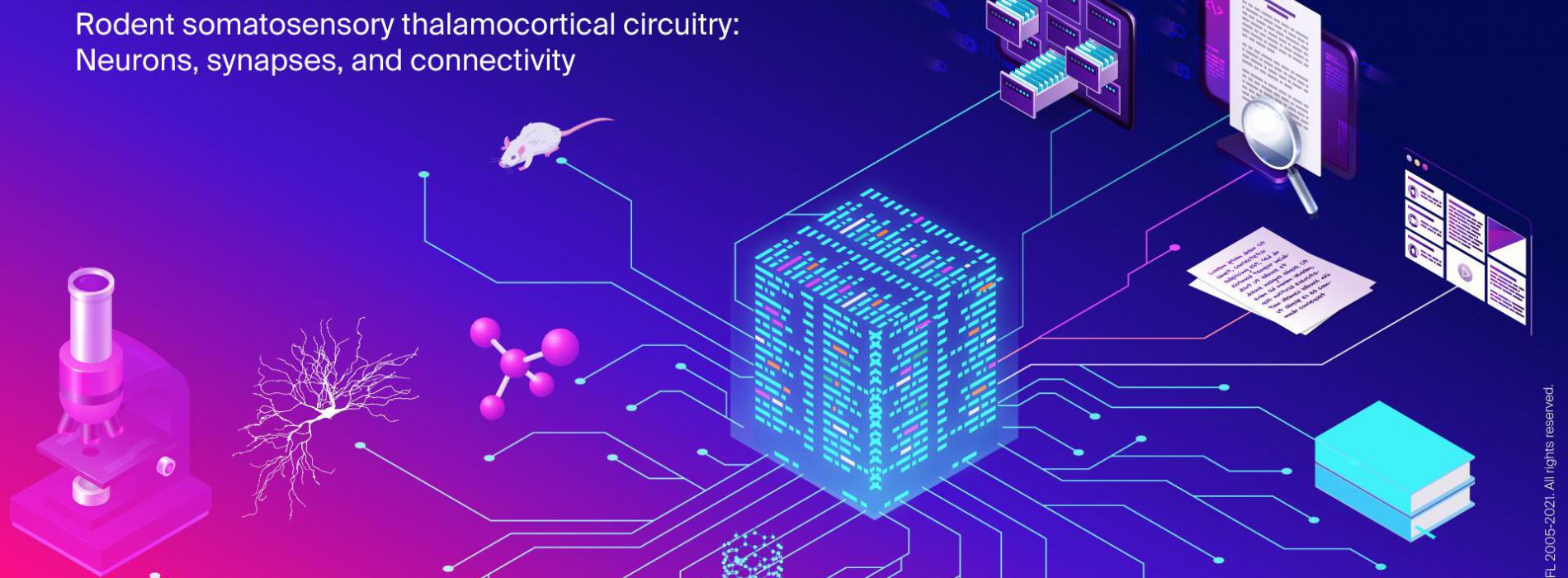
 News
News
What do we know about the rodent thalamocortical circuitry?
The Blue Brain Project follows a four-year roadmap with specific scientific milestones to achieve its ultimate goal, digitally reconstructing and simulating the entire mouse brain. One of the goals in the current period is to model structures with direct relevance for the neocortex. The thalamus is highly interconnected with the cortex and plays an important role in an array of cognitive processes. It funnels sensory input to the neocortex with the thalamocortical loop playing a central role in cerebral rhythmogenesis (biological rhythm). As such, it has a key role in many functions, such as sleep and wakefulness and is involved in various diseases associated with dysfunction of rhythmic activity such as epilepsy, autism, schizophrenia and bipolar disorder. However, there is much that scientists do not know about this brain region and as the understanding of the thalamocortical system deepens, so does the complexity of the questions scientists face.
In the last decade, large-scale in silico simulations have been developed with an ever-increasing level of biophysical detail which allows for a better understanding of such complex systems. Simulation neuroscience has also proven to be invaluable for guiding or corroborating experimental investigations. Recent studies in this area have demonstrated how small volumes of brain tissue can be simulated using morphologically and biophysically detailed neuron models (Markram et al., 2015). While, less detailed frameworks have also been used to perform large-scale simulations at the microscopic and mesoscopic scale. These simulation frameworks provide platforms to integrate available knowledge and push forward our understanding of cross-scale, cross-species, and cross-modalities mechanisms underlying cognition and behavior.
A comprehensive knowledge review of the rodent somatosensory thalamocortical circuitry
“In preparation for computationally modelling this complex circuit (as per Blue Brain’s data-driven modelling process), we have undertaken and published an in-depth study of the current data and knowledge about the circuitry of the somatosensory thalamocortical system in rodents,” explains Blue Brain Scientist, Elisabetta Iavarone. “By conducting such a broad review of many data sources and scientists, we were able to get really close to the data and this enabled us to put together an extensive review of the different levels of organization, including the cells, synapses, neuroanatomy, and network connectivity. Furthermore, we provide an overview of the thalamocortical interdependencies from a modelling perspective. This review of the thalamic microcircuitry concludes that we understand the over-arching mechanics of the loop but there are still some key gaps in our knowledge,” she discloses.
Having identified these gaps, the authors discuss what should be the focus for future research and the importance of combining experimental and modelling investigations for a more complete picture. Filling these gaps would provide invaluable information for systematically unveiling how this system supports behavioral and cognitive processes.
The review also concludes that high-resolution and high-throughput experimental recording methods can be increasingly relied on, however, the potential of these new methods will only be fully harnessed if the community manages to pool together quantitative experimental results from various sources. Reaching this level of data integration is essential to tackle fundamental challenges associated with high experimental variability and low reproducibility, interspecies differences, complex developmental trajectories, and anomalies due to diseases and idiosyncratic conditions.
Experimental advances paving the way for great leaps in our understanding
A key point from the researchers is that, impressive methodological developments are promising speedy progress on long-standing issues. In addition, since its introduction over a decade ago, optogenetics has allowed researchers to design in vivo experimental protocols that provided a strong foundation to dissect neuronal networks in more natural conditions (Deisseroth, 2015). These advances have been further supported by the recent development of miniaturized imaging equipment, such as miniscope and gradient-index lenses (Ghosh et al., 2011).
With these in vivo experimental tools, scientists can now probe the inner workings of sleep, sensory processing, and behavior. These new methods are likely to help shed a new light on cellular and network-level mechanisms involved in diseases associated with abnormal thalamic rhythmogenesis, as previously reported for conditions like epilepsy, schizophrenia, and autism.
“Decades of study means that the vast majority of our knowledge remains in the literature,” confirms Prof. Sean Hill. “Combined with fast-paced improvement in modelling methodologies and the steady increase of available computational power, these advances are paving the way for great leaps in our understanding of the thalamocortical system. Our next step is to use this valuable literature review and combine it with datasets to build a large-scale model of the thalamus in silico. While we are using this review as a pre-cursor for modelling in the Blue Brain Project, we hope it is a useful reference for both entry-level and highly experienced neuroscientists as well as computational modelers studying the thalamocortical system,” he concludes.
Read the paper - O’Reilly, Christian, Iavarone, Elisabetta, Yi, Jane, & Hill, Sean L. (2021). Rodent somatosensory thalamocortical circuitry: Neurons, synapses, and connectivity. Neuroscience & Biobehavioral Reviews, 126, 213–235. https://doi.org/10.1016/j.neubiorev.2021.03.015
Funding
This research has been supported by McGill’s Azrieli Centre for Autism Research (ACAR) and the Fonds de recherche du Québec – Santé (FRQS), the Krembil Foundation, and by general funding from the ETH Board of the Swiss Federal Institutes of Technology to the Blue Brain Project of the École polytechnique fédérale de Lausanne.